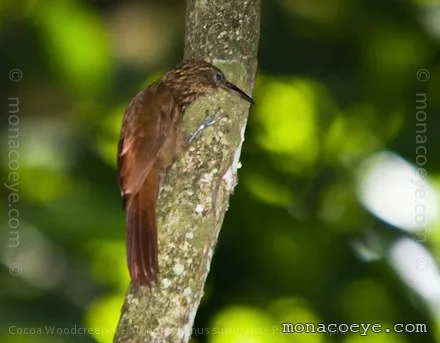
Cocoa Woodcreeper
[order] PASSERIFORMES | [family] Furnariidae | [latin] Xiphorhynchus susurrans | [UK] Cocoa Woodcreeper | [FR] Grimpar cacao | [DE] Tropfenstirn-Baumsteiger | [ES] Trepatroncos Cacao | [NL]
Subspecies
| Genus | Species | subspecies | Breeding Range | Breeding Range 2 | Non Breeding Range |
| Xiphorhynchus | susurrans | LA | e Guatemala to n Venezuela | ||
| Xiphorhynchus | susurrans | confinis | |||
| Xiphorhynchus | susurrans | costaricensis | |||
| Xiphorhynchus | susurrans | jardinei | |||
| Xiphorhynchus | susurrans | margaritae | |||
| Xiphorhynchus | susurrans | marginatus | |||
| Xiphorhynchus | susurrans | nana | |||
| Xiphorhynchus | susurrans | rosenbergi | |||
| Xiphorhynchus | susurrans | susurrans |
Physical charateristics
This woodcreeper is 27-28 cm long, and weighs 64g. The head and neck are buff-streaked dark brown, the upper back is lightly streaked dark brown, and the rest of the upperparts, wings and tail are rufous. The underparts are olive-brown with broad cinnamon streaks on the breast. The bill is long, pale, slightly decurved, and hooked at the tip.
| wingspan min.: | 0 | cm | wingspan max.: | 0 | cm |
| size min.: | 27 | cm | size max.: | 28 | cm |
| incubation min.: | 18 | days | incubation max.: | 19 | days |
| fledging min.: | 19 | days | fledging max.: | 19 | days |
| broods: | 1 | eggs min.: | 1 | ||
| eggs max.: | 3 |
Range
Latin America : East Guatemala to North Venezuela
Habitat
It chiefly inhabits humid lowland forest, although habitat preferences vary geographically, and in some areas it can also be found in semi-deciduous and gallery forests, palm swamps, cerrado woodland, mature mangroves, clearings with scattered trees and plantations. It is most abundant below 900 m, although it occurs in small numbers at high altitudes, locally to 2400 m in Venezuela.
Reproduction
The species builds a bark-lined nest in a, usually low placed, tree hole or hollow stump. Clutch size is 2 eggs.
Feeding habits
It feeds primarily on arthropods, but also on small vertebrates, taken by gleaning, pecking or probing into bark crevices, dead leafs, clumps of moss or knotholes. It is a regular associate of mixed-species flocks frequenting the mid-levels and subcanopy. It feeds low in trees, usually alone, but groups will follow columns of army ants.
Conservation
This species has a very large range, and hence does not approach the thresholds for Vulnerable under the range size criterion (Extent of Occurrence <20,000 km2 combined with a declining or fluctuating range size, habitat extent/quality, or population size and a small number of locations or severe fragmentation). The population trend appears to be stable, and hence the species does not approach the thresholds for Vulnerable under the population trend criterion (>30% decline over ten years or three generations). The population size has not been quantified, but it is not believed to approach the thresholds for Vulnerable under the population size criterion (<10,000 mature individuals with a continuing decline estimated to be >10% in ten years or three generations, or with a specified population structure). For these reasons the species is evaluated as Least Concern.
Found from southeast Colombia to the Guyanas, excluding most of the Guiana Shield, and also in the northern Mata Atl
Found from southeast Colombia to the Guyanas, excluding most of the Guiana Shield, and also in the northern Mata Atl
